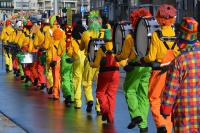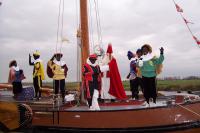Days of the week, months and seasons in Dutch
Sign up for free to get all information about private lessons and our available group courses (A1, A2, B2, B2, C1, C2)
Sign up for freeSign up for free to get all information about private lessons and our available group courses (A1, A2, B2, B2, C1, C2)
Sign up for freeIn this chapter, you will learn the days of the week, the months and the seasons in Dutch. These words are useful for when making an appointment or when telling people when you celebrate your birthday. You'll also find some information about Dutch holidays in this chapter.
| Dutch | English |
|---|---|
| Maandag | Monday |
| Dinsdag | Tuesday |
| Woensdag | Wednesday |
| Donderdag | Thursday |
| Vrijdag | Friday |
| Zaterdag | Saturday |
| Zondag | Sunday |
![]() Unlike the English days of the week, the days of the week in Dutch are typically not capitalized (unless they're the first word of the sentence).
Unlike the English days of the week, the days of the week in Dutch are typically not capitalized (unless they're the first word of the sentence).
Take online language lessons with a professional teacher
In this table you will find the translations of the parts of the day from Dutch to English.
| Dutch | English |
|---|---|
| Ochtend/morgen | Morning |
| Middag | Noon |
| Namiddag | Afternoon |
| Avond | Evening |
| Nacht | Night |
| Middernacht | Midnight |
The table below will show you the months of the year in Dutch.
| Dutch | English |
|---|---|
| Januari | January |
| Februari | February |
| Maart | March |
| April | April |
| Mei | May |
| Juni | June |
| Juli | July |
| Augustus | August |
| September | September |
| Oktober | October |
| November | November |
| December | December |
![]() The words for the months in Dutch are similar to the English months, but as with the days, the Dutch months are not capitalized.
The words for the months in Dutch are similar to the English months, but as with the days, the Dutch months are not capitalized.
In this table you will find the translations of the seasons from Dutch to English.
| Dutch | English |
|---|---|
| Lente; voorjaar | Spring |
| Zomer | Summer |
| Herfst, najaar | Fall |
| Winter | Winter |
| In de lente | In spring |
| In de zomer | In summer |
| In de herfst | In fall |
| In de winter | In winter |
In the table below the Dutch translations of international, mostly Christian holidays are shown.
| Dutch | English | Date |
|---|---|---|
| Nieuwjaarsdag | New Year's Day | 1 January |
| Valentijnsdag | Valentine's day | 14 February |
| Goede vrijdag | Good Friday | The Friday before Easter |
| Pasen | Easter | The first Sunday after the first full moon in spring. |
| Hemelvaartsdag | Ascension Day | 39 days after Easter |
| Pinksteren | Whitsunday | The seventh Sunday after Easter |
| Kerstmis | Christmas | 25 December |
| Tweede Kerstdag | Boxing Day | 26 December |
Beside these international holidays, there are also some holidays that only are celebrated in the Netherlands (in most cases). Some information about these holidays is provided below.
 'Carnaval' is celebrated from the 6th Sunday before Easter until the Tuesday before Ash Wednesday. Carnaval is mainly celebrated in the Southern part of the Netherlands (Limburg and North-Brabant). During Carnaval, people wear a weird costume and they celebrate for 4 days. The so-called Prince Carnaval is the mayor of the city/village during these days and is in charge of the festivities. During Carnaval there are many parades with Carnaval vehicles and a lot of beer is being drunk.
'Carnaval' is celebrated from the 6th Sunday before Easter until the Tuesday before Ash Wednesday. Carnaval is mainly celebrated in the Southern part of the Netherlands (Limburg and North-Brabant). During Carnaval, people wear a weird costume and they celebrate for 4 days. The so-called Prince Carnaval is the mayor of the city/village during these days and is in charge of the festivities. During Carnaval there are many parades with Carnaval vehicles and a lot of beer is being drunk.
On 'Koningsdag' the birthday of King Willem-Alexander is celebrated. On King's Day there are a lot of music festivals, street parties, flea markets and fairs in Dutch cities. The King and his family pay a visit to one Dutch city, in 2017 they visited Tilburg. On King's Day most people wear orange clothes, the national colour of The Netherlands.
On the 4th of May the 'Dodenherdenking' takes place. All victims (civilians and soldiers) who have been killed or murdered in the Kingdom of the Netherlands or anywhere in the world in war situations or during peace-keeping operations since World War II are remembered. At 8 pm, the Dutch people participate in 2 minutes of silence. The main Dodenherdenking ceremony takes place on the Dam Square in Amsterdam, the royal family and members of cabinet attend this ceremony and it is broadcasted live on national television.
The day after Dodenherdenking is a day to celebrate, called 'Bevrijdingsdag'. This day marks the end of the German occupation of the Netherlands during the Second World War. Liberation Day is celebrated with free music festivals in 14 cities throughout the Netherlands.
On 'Prinsjesdag', the new working year of the Staten-Generaal is opened. The Staten-Generaal consists of the First Chamber (Senate) and the Second Chamber (Lower House). On Prinsjesdag, King Willem-Alexander will give the annual Troonrede in the Ridderzaal in The Hague. The most important plans of the Staten-Generaal for the upcoming year are mentioned in the 'Troonrede'. At 3.15 pm, the Minister of Finance hands over 'het koffertje' (the small suitcase) in which the 'Miljoenennota' (Budget Memorandum) and the 'Rijksbegroting' (Government Budget) are kept to Second Chamber (Lower House).
 'Sinterklaas' is an annual celebration for children. Sinterklaas is a legendary figure based on Saint Nicholas. In mid-November Sinterklaas and his Zwarte Pieten "arrive" by steamboat in The Netherlands, saying that they come from Spain. After this, there is a parade through the town. During this parade Sinterklaas usually rides his white horse (called Amerigo) while Zwarte Piet hands out candy (kruidnoten and marsepein) to children. In the period leading up to Sinterklaasavond children place their shoe at the fireplace since the story goes that Sinterklaas rides with his horse over rooftops to deliver presents to children through the chimney. On the 5th of December it is Sinterklaasavond, during this evening presents are exchanged among families.
'Sinterklaas' is an annual celebration for children. Sinterklaas is a legendary figure based on Saint Nicholas. In mid-November Sinterklaas and his Zwarte Pieten "arrive" by steamboat in The Netherlands, saying that they come from Spain. After this, there is a parade through the town. During this parade Sinterklaas usually rides his white horse (called Amerigo) while Zwarte Piet hands out candy (kruidnoten and marsepein) to children. In the period leading up to Sinterklaasavond children place their shoe at the fireplace since the story goes that Sinterklaas rides with his horse over rooftops to deliver presents to children through the chimney. On the 5th of December it is Sinterklaasavond, during this evening presents are exchanged among families.
Train your skills by doing the exercises below!